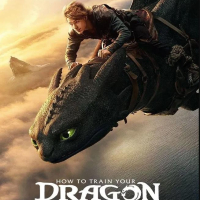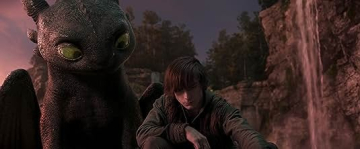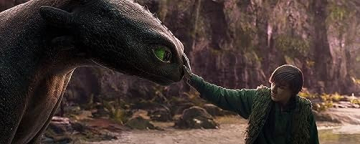A Brave Return to the Skies: Reviewing How to Train Your Dragon (2025)
Fifteen years after the original How to Train Your Dragon soared into theaters and captured a generation of viewers, DreamWorks Animation returns with a fourth and likely final installment that is less a sequel and more a spiritual epilogue. How to Train Your Dragon (2025) is not about rekindling the spectacle of the past — though it delivers stunning visuals and high-stakes moments — but rather about understanding how legacies evolve, how stories are passed on, and how even dragons must sometimes fade into myth before they can re-emerge with meaning.
This is a film that doesn’t just cater to the audience that grew up with Hiccup and Toothless — it *respects* them. It treats maturity not as a burden but as a lens. The core message is no longer just about friendship or bravery but about inheritance, climate, coexistence, and rediscovery. The result is a beautifully realized journey that dares to slow down, reflect, and then — when it finally takes flight — soars in ways few animated films ever manage.
A Story Rooted in Change
Set around twenty years after the dragons disappeared into the Hidden World, the island of Berk has modernized. There are fishing drones, wind turbines, and touchscreens in the hands of children who don’t believe in dragons anymore. Hiccup, now older, bearded, and less certain, has stepped down from leadership. He and Astrid live on the outskirts, raising their teenage daughter Lyra in the shadow of a forgotten era.
Lyra is no believer. Raised on scientific skepticism and curious about her parents’ cryptic past, she views dragons as exaggerated stories from a sentimental age. But when strange natural disturbances begin disrupting ocean currents and weather patterns, and when a rare artifact surfaces from the deep — bearing unmistakable dragon markings — the old world begins to stir. What follows is not a quest in the traditional sense, but a journey into memory and myth, where Lyra must decide what kind of future she believes in and what kind of world she hopes to protect.
The writing is subtle. Dialogue between generations is layered with misunderstanding and love, and the film excels at portraying the tension between letting go and holding on. It’s not just about finding dragons; it’s about understanding *why* they mattered in the first place.
Visual Storytelling Elevated
Visually, How to Train Your Dragon (2025) is a masterpiece of animation evolution. The texturing, lighting, and cinematography reflect a studio that has refined its craft to a near-photorealistic level while preserving the poetic motion of animation. The stormy seas, bio-luminescent caves, and hidden valleys that appear later in the story are rendered with breathtaking care. Even when watched online or streamed in high definition, the film’s atmosphere and detail remain immersive.
The dragons themselves — few and awe-inspiring — are designed with reverence. Their anatomy reflects years of adaptation in isolation: longer wings, spectral scales, and movements that feel alien yet familiar. These aren’t just creatures to befriend; they are beings to be understood. That shift in tone is intentional, and it pays off by treating younger viewers to a more sophisticated kind of wonder and older audiences to a deeper kind of awe.
Performances That Reflect Growth
Jay Baruchel returns as Hiccup with a performance grounded in introspection. The youthful stammer has been replaced by calm weariness, and his voice carries the weight of someone who has seen beauty disappear for the right reasons. America Ferrera as Astrid remains the soul of the film, her loyalty and practical wisdom anchoring both her husband and daughter in moments of crisis.
Maude Apatow voices Lyra with believable emotional range, shifting from defiant to vulnerable, from skeptic to believer, without ever becoming a cliché. Her arc is arguably the most compelling in the series — a portrait of second-generation identity, filtered through environmental urgency and inherited mythology. Secondary characters are kept to a minimum, and that restraint works in favor of the story’s intimacy. There are no silly distractions or unnecessary side plots; every line matters.
John Powell’s Score Returns to Soar
Composer John Powell, whose musical themes defined the franchise, returns in full force. Yet this is not a recycled score. The familiar motifs echo faintly in the background, reinterpreted with different instrumentation. There’s more use of piano and strings, less of bombastic brass — a change that matches the reflective tone of the film. When dragons reappear, so too does the full musical swell, and it’s nothing short of goosebump-inducing. The score elevates every emotional beat and gives voice to what is often left unspoken.
How to watch How to Train Your Dragon (2025) online
How to Train Your Dragon (2025) is currently available to watch and stream online across several major platforms. Netflix subscribers can stream the film in HD or 4K where available, with a download option for offline viewing. On Amazon Prime Video, the movie is available for rent or purchase, and you can download it to watch unblocked across compatible devices. Apple TV also offers the film in 4K for rent or purchase, with download functionality for mobile and desktop use.
Peacock includes the movie in its Premium subscription package, with streaming and limited download access via the app. Hulu currently offers the film for streaming within select plans, although download features may vary based on region and subscription type. YouTube (Movies) allows users to rent or buy the film, with downloads available through the YouTube app.
The official US age rating for the movie is PG — some scenes contain emotional complexity and mild peril, which may require parental guidance for younger children. That said, it remains an accessible film for family viewing, especially for those willing to engage with its deeper messages.
Pros
- Emotionally mature storytelling with real-world relevance ;
- Stunning animation with cinematic framing and environmental depth ;
- Strong voice performances from returning and new cast ;
- A well-developed new protagonist that enriches the narrative ;
- Rich, immersive score that enhances emotional and visual impact ;
- Respectful and natural pacing that suits the story’s themes ;
Cons
- Pacing may feel slow for younger viewers or those expecting non-stop action ;
- Limited screen time for classic supporting characters from the original trilogy ;
- Requires familiarity with earlier films for full emotional payoff ;










